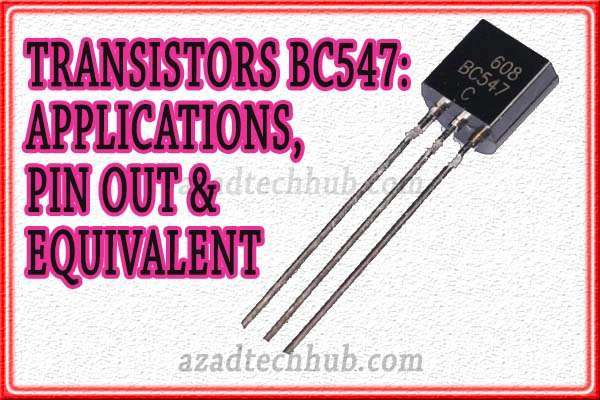BC547B Pinout: Important Features & Equivalent
The BC547B is a commonly used NPN bipolar junction transistor (BJT) that finds applications in various electronic circuits. Understanding BC547B Pinout is essential for correctly connecting it in a circuit.
Read More

BC547B Pinout
Let’s explore the BC547B pinout in detail.
The BC547B transistor has three pins: the emitter (E), base (B), and collector (C). The pinout configuration is as follows:
Emitter (E): The emitter is the first pin of the BC547B transistor, denoted by “E” in the datasheet. It is typically represented with an arrowhead pointing outward. The emitter is connected to the majority charge carriers (electrons for NPN transistors) and is the reference point for current flow.
Base (B): The base is the second pin of the BC547B transistor, denoted by “B” in the datasheet. It is responsible for controlling the current flow between the emitter and the collector. The base pin is thinner than the other two pins and is located between the emitter and the collector.
Collector (C): The collector is the third pin of the BC547B transistor, denoted by “C” in the datasheet. It is the output terminal and carries the majority of the current in the transistor. The collector pin is usually connected to the positive supply voltage in most circuit configurations.
The BC547B pinout configuration is often depicted in a triangular arrangement, with the flat side of the triangle representing the transistor body and the pins extending outward from the triangle’s vertices.
The emitter pin is typically on the left side, the base pin is in the center, and the collector pin is on the right side.
When using the BC547B transistor in a circuit, it is crucial to connect the pins correctly to ensure proper operation and avoid damaging the transistor. Referencing the BC547B pinout diagram or datasheet will help identify and connect the pins accurately in accordance with the desired circuit configuration.
Features of BC547B Transistor:
- NPN bipolar junction transistor (BJT)
- High current gain (hFE) of typically 110 to 800
- Low saturation voltage for efficient switching applications
- Suitable for low-power amplification and switching purposes
- High voltage breakdown capability
Specifications of BC547B Transistor:
- Maximum collector current (IC) of 100 mA
- Maximum collector-base voltage (VCBO) of 50 V
- Maximum collector-emitter voltage (VCEO) of 45 V
- Maximum power dissipation (Ptot) of 500 mW
- Transition frequency (fT) of 300 MHz
- Operating temperature range typically from -55°C to +150°C
Where to Buy BC547 Transistor
[wptb id=11154]Equivalent ICs of BC547B:
BC548, BC549: These are similar NPN transistor variants with slight differences in electrical characteristics and voltage ratings. They can be used as alternatives to the BC547B in many applications.
2N3904: This is another popular NPN transistor that shares similar characteristics with the BC547B and can serve as a suitable replacement.
PN2222A: This is an NPN transistor with comparable characteristics and pinout configuration to the BC547B. It can be used interchangeably in many circuit designs.
These equivalent ICs offer similar functionality and can be used as drop-in replacements for the BC547B in various electronic circuits, depending on specific requirements and availability.
Related Posts:
- Floating Gate Transistor: Best Features & Applications
- TIP120 Transistor Pinout, Datasheet and Equivalent
- TIP122 Transistor Pinout, Datasheet & Applications
- Transistors BC547: Important Guide to Pinout
- C1815 Datasheet: Important Features to Know About
Subscribe to our Newsletter “Electrical Insights Daily” to get the latest updates in Electrical Engineering. You can also Follow us LinkedIn and Facebook to see our latest posts on Electrical Engineering Topics.
